
Global warming caused by CFCs, not carbon dioxide
Waterloo researcher says climate has been on a cooling trend since 2002, matching a decline in CFCs in our atmosphere.

Waterloo researcher says climate has been on a cooling trend since 2002, matching a decline in CFCs in our atmosphere.
By Staff Communications and Public AffairsChlorofluorocarbons (CFCs) are to blame for global warming since the 1970s and not carbon dioxide, according to a Waterloo study just published in the International Journal of Modern Physics B.
CFCs are already known to deplete ozone, but in-depth statistical analysis now shows that CFCs are also the key driver in global climate change, rather than carbon dioxide (CO2) emissions, according to research by Qing-Bin Lu, a professor in the Faculty of Science at the University of Waterloo.
"Conventional thinking says that the emission of human-made non-CFC gases such as carbon dioxide has mainly contributed to global warming. But we have observed data going back to the Industrial Revolution that convincingly shows that conventional understanding is wrong,” says Lu, a professor of physics and astronomy, biology and chemistry.
“In fact, the data shows that CFCs conspiring with cosmic rays caused both the polar ozone hole and global warming,” he adds.
Before CFCs were banned, they were used in aerosols and as coolants in refrigerators and air conditioners. They were also used in the production of insulation and Styrofoam food packaging.
Data important to policy makers
“This study underlines the importance of understanding the basic science underlying ozone depletion and global climate change,” says Terry McMahon, dean of Waterloo’s Faculty of Science. “This research is of particular importance not only to the research community, but to policy makers and the public alike as we look to the future of our climate.”
Lu says his data actually suggests there will be a global cooling. "Most conventional theories expect that global temperatures will continue to increase as CO2 levels continue to rise, as they have done since 1850. What’s striking is that since 2002, global temperatures have actually declined – matching a decline in CFCs in the atmosphere,” says Lu.
“My theoretical calculations of CFC greenhouse effect,not simply correlations, show that there was global warming by ~0.6 °C from 1950 to 2002, but the earth has actually cooled since 2002. The cooling trend is set to continue for the next 50-70 years as the amount of CFCs in the atmosphere continues to decline.”
Lu’s recent papers on the ozone hole and global climate change were published in Physical Review Letters, Physics Reports, and Journal of Cosmology.

Read more
Here are the people and events behind some of this year’s most compelling Waterloo stories

Read more
Discovery of a thick atmosphere on a lava world reshapes our understanding of rocky exoplanets

Dr. Brian Dixon, professor of biology at the University of Waterloo says there is a link between cold weather and getting sick. (University of Waterloo)
Read more
Waterloo researcher shares why we get sick when the mercury dips
The University of Waterloo acknowledges that much of our work takes place on the traditional territory of the Neutral, Anishinaabeg, and Haudenosaunee peoples. Our main campus is situated on the Haldimand Tract, the land granted to the Six Nations that includes six miles on each side of the Grand River. Our active work toward reconciliation takes place across our campuses through research, learning, teaching, and community building, and is co-ordinated within the Office of Indigenous Relations.